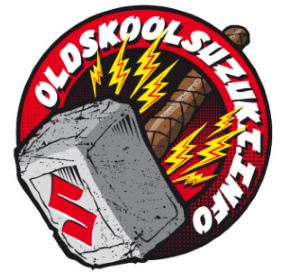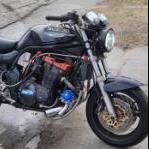

Arttu
Members-
Posts
970 -
Joined
-
Last visited
-
As you said fixed fuel pressure is widely used on OEM cars and bikes but mainly on NA engines. It can work also on boosted engines but higher boost you use less ideal it gets. Effective fuel pressure drops as th boost goes up and naturally fuel flow of the injector drops too. So to compensate that you need either bigger injectors or higher fuel pressure. This will make idle and low load tuning harder than what it would be with boost compensated fuel pressure. And to clarify one quite common misbelief, the purpose of a 1:1 boost compensated fuel pressure isn't to provide any extra fuel for boost. It just keeps the effective fuel pressure constant so that the injectors flow the same amount of fuel per time regardless of the manifold air pressure. All boost enrichment must happen by increased injection pulse length commanded by the ECU.
-

Bandit 1200 with 'busa pistons info and potential upgrade path
Arttu replied to rerb's topic in Forced Induction
Was that deck height measurement with or without head gasket? If the gasket was included then the discrepancy is only 0.25mm which isn't that dramatic. I'm pretty sure the Wossner turbo pistons have bigger dish volume than the stock ones. That's the main idea of low compression pistons, to get lower compression while maintaining good squish gap. -

Bandit 1200 with 'busa pistons info and potential upgrade path
Arttu replied to rerb's topic in Forced Induction
I have to admit that I couldn't follow all your numbers completely But I guess you are aware that Wossner turbo pistons will result lower compression than stock Busa pistons even when you set the squish / deck height the same? Also I'm wondering how you got 1.0mm squish with 1.25mm deck height (if I understood your description correctly)? Squish should be deck height + gasket thickness. Otherwise ~9.5:1 compression and 1.0mm squish sound pretty good to me. On pump gas you should be able to run it up to 15 psi, at least. Probably more with water-meth injection. And on E85 it should be good for 30 psi or so. -
I think it's good to keep in mind that it's a 40 year old bike. So the actual condition can be whatever regardless of the mileage. You can get an engine that is in worse condition after 20 000km than this one which has done 140 000km. It depends so much on maintenance, usage, luck and so on. Naturally 140 000 is a lot so for sure the engine won't be like a new even in the best case. After all buying this old bike is always some kind gamble. You can try to judge the condition as well as you can and think if that aligns with the price. But you can't be completely sure what you will get and surprises can always come up. Smaller or bigger ones. If you want to awoid them it's better to look for newer bikes
-
I think if you go by the book the gears definitely must be designed as pairs. But apparently in real life you can bend that rule somehow. There are some aftermarket gearbox gears that allow changing the ratio by replacing only single gear. Also similar high speed oil pump gears are quite common. I guess strength and longevity aren't as good as with a matching pair.
-
Yes, definitely a good idea to first measure what compression ration and squish band you have now. Then you can work out what you need to do. And yes, solder wire or clay is one way to measure the squish gap. Or you can measure piston to deck height and head gasket thickness, should be the same. I would aim somewhere between 1.0-1.5mm, preferably to the smaller end if possible. For E85 10-11:1 compression should be good.
-
I think stock Busa pistons are used for over 500hp. I wouldn't worry about their strength as long as you can keep the tuning right. So replacing them with aftermarket pistons at the same compression sounds like wasted money... Instead I would concentrate getting the deck height and squish gap correct. Using Busa rods could be a good choice for that.
-
I would simply forget about that 9000 rpm spec for the rods. They seem to have that for pretty much all their rods, including GSX-R1000 ones which are routinely revved up to 12000+ without issues...
-
In theory, yes. But they also have their own problems why they aren't the best solution for modified engines. Usually combining TPS and MAP in some way is a good solution for bike engines.
-
Smoothness of the MAP signal isn't the problem. As you say it can be sorted out relatively easily. The main problem is that usually with individual throttles the measured pressure doesn't correlate very well with load / air flow. When you gradually open the throttle the pressure increases but reaches the ambient pressure (or boost) pretty quickly. Beyond that point there is no change in the pressure but actual air flow still keeps increasing while the throttle gets more open. Systems with single throttle and common plenum (=typical car engine) don't have this problem. Engine phase detection with MAP is somewhat different problem. There you want a clear jump in the MAP reading during the intake stroke but accuracy of measured pressure isn't important.
-
No, it's not. At least as long as we speak about individual throttles per cylinder.
-
Advice: https://www.proboost.fi/motorcycle-turbo-kits
-
It depends heavily on injector size. With relatively small injectors, like up to around 500cc/min, you can use even a dead head rail without any major issues. Like most of the stock EFI bikes do. But with bigger injectors the fuel pressure pulsing gets stronger and may start causing all kind weird tuning issues. Flow through fuel rail is the first and most important improvement. When fuel is flowing through the rail back to the regulator the flow in the rail doesn't need to stop and start moving again when the injector pulse. This reduces pulsing a lot and usually it's good enough even for pretty extreme injectors if the rail ID is big enough. Pressure compensators / accumulators can improve situation even further but like said usually they aren't necessary. Only cases where I really had needed them are nitro engines with 7000+cc/min injectors...
-
Yeah, ideally you want to point the injectors towards the valves but in reality it isn't that critical. However, further down to the port you can get the spray before hitting the walls the better. All this matter quite little at full throttle and high rpm when the air flow is strong enough to keep the fuel moving. But at lower rpms it may have noticeable effect. Especially during throttle transitions. More "wet" intake wall surface you have more you need acceleration enrichment. And excessive acceleration enrichment will cause all kind side effects that can be difficult to compensate. But as said above, don't worry too much about this. Do what you can to get them at good angle but compromises are fine.
-
No. It needs just reliable boost pressure sensing and then fuel delivery can be programmed to whatever is needed. Generally speaking.



